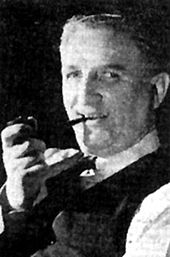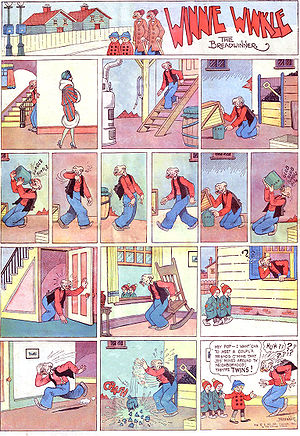
Martin Branner
Encyclopedia

Winnie Winkle
Winnie Winkle was an American comic strip which appeared over a 76-year span . Created by Martin Branner, who wrote the strip for over 40 years, Winnie Winkle was one of the first comic strips about working women. It was titled Winnie Winkle the Breadwinner until 1943...
. He was born in New York, a twin and one of nine children of Bernard Brenner, a Jewish immigrant lacemaker and small-time New York politician.
Vaudeville
In 1905, Martin Branner was an assistant to two men who booked vaudevilleVaudeville
Vaudeville was a theatrical genre of variety entertainment in the United States and Canada from the early 1880s until the early 1930s. Each performance was made up of a series of separate, unrelated acts grouped together on a common bill...
acts. He was a dancer who met Edith Fabbrini (1892–1966) when he was 18 and she was 15. They married a few days after they met, and the couple then entered vaudeville as a dance team. Billed as Martin and Fabbrini, they spent 15 years performing in stock, musical comedy and vaudeville on the Keith Orpheum
Benjamin Franklin Keith
Benjamin Franklin Keith was an American vaudeville theatre owner, highly influential in the evolution of variety theater into vaudeville.-Early years:...
and Pantages
Alexander Pantages
Alexander Pantages was an American vaudeville and early motion picture producer and impresario who created a large and powerful circuit of theatres across the western United States and Canada.-Early life:...
circuits. In Manhattan, Martin and Fabbrini played the Palace Theater the second week it opened, and they often made return engagements.
Some of Branner's earliest artwork was published during this period when he did advertising illustrations for Variety
Variety (magazine)
Variety is an American weekly entertainment-trade magazine founded in New York City, New York, in 1905 by Sime Silverman. With the rise of the importance of the motion-picture industry, Daily Variety, a daily edition based in Los Angeles, California, was founded by Silverman in 1933. In 1998, the...
. Two shows a day sometimes increased to three and more shows daily, but bookings for the dance team became fewer during and following World War I
World War I
World War I , which was predominantly called the World War or the Great War from its occurrence until 1939, and the First World War or World War I thereafter, was a major war centred in Europe that began on 28 July 1914 and lasted until 11 November 1918...
.
Branner served his WWI military duty with the Chemical Warfare Service of the U.S. Army. On his return after WWI, he left vaudeville and launched a new career as a cartoonist in 1919, beginning with a short-lived strip, Looie the Lawyer, for the Bell Syndicate
Bell Syndicate
The Bell Syndicate, launched in 1916 by editor-publisher John Neville Wheeler, was an American syndicate which distributed columns, fiction, feature articles and comic strips to newspapers for decades...
. He followed with a Sunday page
Sunday strip
A Sunday strip is a newspaper comic strip format, where comic strips are printed in the Sunday newspaper, usually in a special section called the Sunday comics, and virtually always in color. Some readers called these sections the Sunday funnies...
, Pete and Pinto, which ran for 20 weeks in the New York Herald
New York Herald
The New York Herald was a large distribution newspaper based in New York City that existed between May 6, 1835, and 1924.-History:The first issue of the paper was published by James Gordon Bennett, Sr., on May 6, 1835. By 1845 it was the most popular and profitable daily newspaper in the UnitedStates...
and The Sun.
Winnie begins
He launched Winnie Winkle the Breadwinner as a daily stripDaily strip
A daily strip is a newspaper comic strip format, appearing on weekdays, Monday through Saturday, as contrasted with a Sunday strip, which typically only appears on Sundays....
in September 1920, followed by a Sunday page in 1923.
By 1939, Winnie Winkle the Breadwinner was printed in 125 newspapers in America and Europe for a combined circulation of more than eight and a half million. The title was shortened to Winnie Winkle in 1943. Edith Branner served as the model for the character of Winnie Winkle. After they retired their dance act, the Branners became the parents of Bernard Donald Branner and the art historian Robert Branner
Robert Branner
Robert Branner was an art historian specializing in Gothic architecture and manuscript illumination. He was born in New York, the son of cartoonist Martin Branner and Edith Fabbrini....
. Martin Branner converted to Roman Catholicism shortly after leaving the stage.
Books
Winnie Winkle and the Diamond Heirlooms by Branner and Helen Berke was a 248-page hardcover novel published by WhitmanWestern Publishing
Western Publishing, also known as Western Printing and Lithographing Company was a Racine, Wisconsin firm responsible for publishing the Little Golden Books. Western Publishing also produced children's books and family-related entertainment products as Golden Books Family Entertainment...
in 1946.
Awards and public career
Branner wrote and drew Winnie Winkle from 1920 to 1962, receiving the National Cartoonists SocietyNational Cartoonists Society
The National Cartoonists Society is an organization of professional cartoonists in the United States. It presents the National Cartoonists Society Awards. The Society was born in 1946 when groups of cartoonists got together to entertain the troops...
Humor Comic Strip Award in 1958. In 1957, Branner was a guest challenger on the television panel show To Tell the Truth
To Tell the Truth
To Tell the Truth is an American television panel game show created by Bob Stewart and produced by Goodson-Todman Productions that has aired in various forms since 1956 both on networks and in syndication...
. He was a noted wit and drew on his vaudeville background for some gags appearing in his cartoons.
Martin and Edith Branner lived at 27 Riverside Drive in Waterford, Connecticut
Waterford, Connecticut
Waterford is a town in New London County, Connecticut, United States. It is named after Waterford, Ireland. The population was 19,152 at the 2000 census. The town center is listed as a census-designated place .-Geography:...
, and they were the designers of Waterford's Town Seal. During their many visits to New York, the Branners enjoyed living in hotels; they were frequent guests at the Iroquois Hotel, which Branner called "the poor man's Algonquin
Algonquin Hotel
The Algonquin Hotel is a historic hotel located at 59 West 44th Street in Manhattan . The hotel has been designated as a New York City Historic Landmark....
."
Assistants

Robert Velter
François Robert Velter , known by his pen-name Rob-Vel, was a French cartoonist. He is best known for creating the character Spirou in 1938.-Biography:...
, and his later, long-time assistant was Max Van Bibber, who took over Winnie Winkle after Branner suffered a stroke in 1962. Following the stroke, Branner began to use a wheelchair. Without the use of his right hand, he continued to draw with his left.
The Branner family usually spent summers boating and swimming in Connecticut. Martin Branner died at age 81 on May 19, 1970, at the Nutmeg Pavilion Convalescent Home in New London, Connecticut
New London, Connecticut
New London is a seaport city and a port of entry on the northeast coast of the United States.It is located at the mouth of the Thames River in New London County, southeastern Connecticut....
.
Archives
Syrcause University's Special Collections house the Martin Branner Cartoons collection of 300 original daily cartoons from Winnie Winkle (1920–1957). There is a complete week from each year represented, with additional random cartoons from each year. There are no holdings for 1946-47. The daily cartoons display traces of graphite, blue pencil, Zipatone, brush, pen and ink on illustration board measuring approximately 7 ¼ x 22 ½ inches.Sources
- Branner family reminiscences
- Strickler, DaveDave StricklerDave Strickler is a reference librarian noted for his compilation of Syndicated Comic Strips and Artists, 1924–1995: The Complete Index, regarded as a major reference work by researchers and historians of newspaper comic strips....
. Syndicated Comic Strips and Artists, 1924-1995: The Complete Index. Cambria, California: Comics Access, 1995. ISBN 0-9700077-0-1

